Related Research Articles
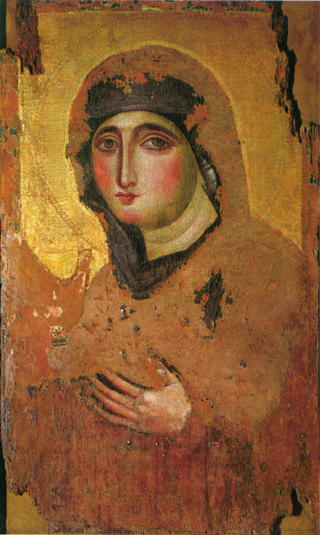
Mary was a first-century Jewish woman of Nazareth, the wife of Joseph and the mother of Jesus. She is a central figure of Christianity, venerated under various titles such as virgin or queen, many of them mentioned in the Litany of Loreto. The Eastern and Oriental Orthodox, Church of the East, Catholic, Anglican, and Lutheran churches believe that Mary, as mother of Jesus, is the Mother of God. Other Protestant views on Mary vary, with some holding her to have lesser status.

Virginity is the state of a person who has never engaged in sexual intercourse. The term virgin originally only referred to sexually inexperienced women, but has evolved to encompass a range of definitions, as found in traditional, modern and ethical concepts. Heterosexual individuals may or may not consider loss of virginity to occur only through penile-vaginal penetration, while people of other sexual orientations often include oral sex, anal sex, or manual sex in their definitions of losing one's virginity.

James the Less is a figure of early Christianity. He is also called "the Minor", "the Little", "the Lesser", or "the Younger", according to translation, in order to differentiate him from James the Great. James the Less has traditionally been commemorated along with St. Philip in the Western Christian calendars. In the Roman Catholic Church their feast day was observed on May 1 until 1955, when it was moved to May 11 to accommodate the Feast of St Joseph the Worker on May 1. A later revision of the calendar moved the feast back to May 3. In many other churches the feast has never moved from May 1.

James the Just, or a variation of James, brother of the Lord, was "a brother of Jesus", according to the New Testament. He was the first leader of the Jerusalem Church of the Apostolic Age. Traditionally, it is believed he was martyred in AD 62 or 69 by being stoned to death by the Pharisees on order of High Priest Ananus ben Ananus. James, Joses, Simon, and Judas are mentioned as the brothers or siblings of Jesus as well as two unnamed sisters.

The brothers of Jesus or the adelphoi are named in the New Testament as James, Joses, Simon, Jude, and unnamed sisters are mentioned in Mark and Matthew. They may have been: (1) the sons of Mary, the mother of Jesus, and Joseph, (2) sons of Mary the wife of Cleophas and sister of Mary, the mother of Jesus; or (3) sons of Joseph by a former marriage. While option 1 is described as the "most natural inference" from the New Testament, those who uphold the perpetual virginity of Mary reject the idea of biological brethren and maintain that the brothers and sisters were either cousins of Jesus or children of Joseph from a previous marriage. The Lutheran Churches have accepted both option 2 and option 3 as being valid explanations for the doctrine of the perpetual virginity of Mary.
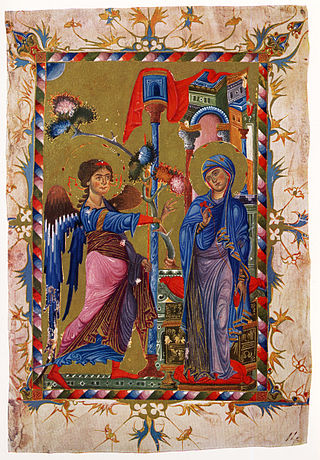
The Annunciation is, according to the Gospel of Luke, the announcement by the archangel Gabriel to Mary that she would conceive and bear a son through a virgin birth and become the mother of Jesus Christ, the Christian Messiah and Son of God, marking the Incarnation. Gabriel told Mary to name her son Jesus.
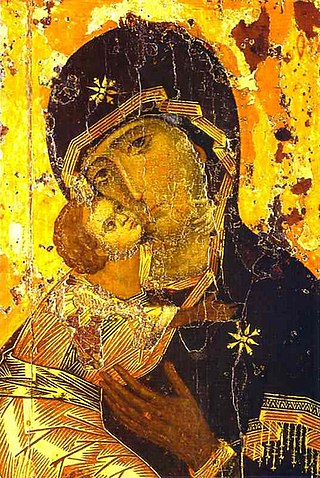
The perpetual virginity of Mary is a Christian doctrine that Mary, the mother of Jesus, was a virgin "before, during and after" the birth of Christ. In Western Christianity, the Catholic Church adheres to the doctrine, as do some Lutherans, Anglicans, Reformed, and other Protestants. Shenouda III, Pope of the Coptic Orthodox Church, affirmed the teaching, and Eastern Orthodox churches recognize Mary as Aeiparthenos, meaning "ever-virgin". It is one of the four Marian dogmas of the Catholic Church. Most modern nonconformist Protestants reject the doctrine.

According to the Gospel of John, Mary of Clopas was one of the women present at the crucifixion of Jesus and bringing supplies for his funeral. The expression Mary of Clopas in the Greek text is ambiguous as to whether Mary was the daughter or wife of Clopas, but exegesis has commonly favoured the reading "wife of Clopas". Hegesippus identified Clopas as a brother of Joseph. In the Roman Martyrology of the Catholic Church she is commemorated with Salome on April 24th.

Catholic Mariology is Mariology in Catholic theology. According to the Immaculate Conception taught by the Catholic Church, she was conceived and born without sin, hence Mary is seen as having a singular dignity above the saints, receiving a higher level of veneration than all angelic spirits and blessed souls in heaven. Catholic Mariology thus studies not only her life but also the veneration of her in daily life, prayer, hymns, art, music, and architecture in modern and ancient Christianity throughout the ages.
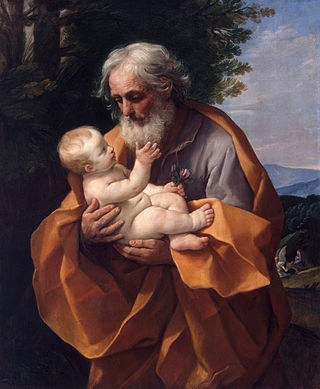
Matthew 1:25 is the twenty-fifth and last verse of the first chapter of the Gospel of Matthew in the New Testament. Joseph has awakened from a dream in which an angel gave him instructions about the birth of Jesus. He has taken Mary into his home, completing their marriage, and this verse explains what occurs once the couple is united.
The Antidicomarians or Antidicomarianites, also called Dimoerites, were a Christian sect active from the 3rd to the 5th century. Their name was invented by an opponent, Epiphanius of Salamis, who described them as heretical in his Panarion. The existence of the Antidicomarians as an organized sect may be doubted, as it is attested only in Epiphanius, but the doctrines he attributes to them were certainly matters of live debate in the late 4th century.
Bonosus may refer to any of:
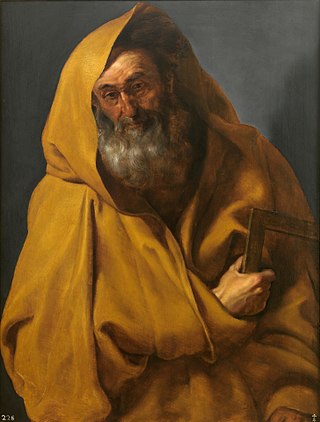
James, son of Alphaeus was one of the Twelve Apostles of Jesus, appearing under this name in all three of the Synoptic Gospels' lists of the apostles. He is generally identified with James the Less and commonly known by that name in church tradition. He is also labelled "the Minor", "the Little", "the Lesser", or "the Younger", according to translation. He is distinct from James, son of Zebedee and in some interpretations also from James, brother of Jesus. He appears only four times in the New Testament, each time in a list of the twelve apostles.

Mariology is the theological study of Mary, the mother of Jesus. Mariology seeks to relate doctrine or dogma about Mary to other doctrines of the faith, such as those concerning Jesus and notions about redemption, intercession and grace. Christian Mariology aims to place the role of the historic Mary in the context of scripture, tradition and the teachings of the Church on Mary. In terms of social history, Mariology may be broadly defined as the study of devotion to and thinking about Mary throughout the history of Christianity.

Protestant views on Mary include the theological positions of major Protestant representatives such as Martin Luther and John Calvin as well as some modern representatives. While it is difficult to generalize about the place of Mary, mother of Jesus in Protestantism given the great diversity of Protestant beliefs, some summary statements are attempted.

Throughout history, Catholic Mariology has been influenced by a number of saints who have attested to the central role of Mary in God's plan of salvation. The analysis of Early Church Fathers continues to be reflected in modern encyclicals. Irenaeus vigorously defended the title of "Theotokos" or Mother of God. The views of Anthony of Padua, Robert Bellarmine and others supported the doctrine of the Immaculate Conception of the Virgin Mary, which was declared a dogma in 1850.
Lutheran Mariology or Lutheran Marian theology is derived from Martin Luther's views of Mary, the mother of Jesus and these positions have influenced those taught by the Lutheran Churches. Lutheran Mariology developed out of the deep Christian Marian devotion on which Luther was reared, and it was subsequently clarified as part of his mature Christocentric theology and piety. Lutherans hold Mary in high esteem, universally teaching the dogmas of the Theotokos and the Virgin Birth. Luther dogmatically asserted what he considered firmly established biblical doctrines such as the divine motherhood of Mary while adhering to pious opinions of the Immaculate Conception and the perpetual virginity of Mary, along with the caveat that all doctrine and piety should exalt and not diminish the person and work of Jesus Christ. By the end of Luther's theological development, his emphasis was always placed on Mary as merely a receiver of God's love and favour. His opposition to regarding Mary as a mediatrix of intercession or redemption was part of his greater and more extensive opposition to the belief that the merits of the saints could be added to those of Jesus Christ to save humanity. Lutheran denominations may differ in their teaching with respect to various Marian doctrines and have contributed to producing ecumenical meetings and documents on Mary.
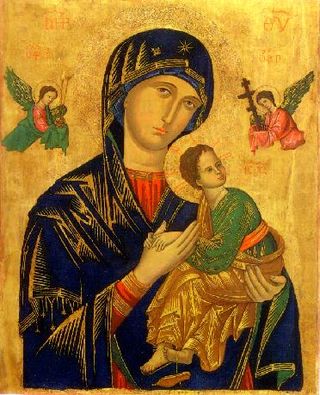
Mary has been one of the major subjects of Western art for centuries. There is an enormous quantity of Marian art in the Catholic Church, covering both devotional subjects such as the Virgin and Child and a range of narrative subjects from the Life of the Virgin, often arranged in cycles. Most medieval painters, and from the Reformation to about 1800 most from Catholic countries, have produced works, including old masters such as Michelangelo and Botticelli.
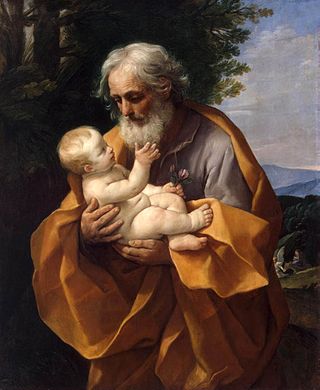
Joseph was a 1st-century Jewish man of Nazareth who, according to the canonical Gospels, was married to Mary, the mother of Jesus, and was the legal father of Jesus.

Simon is described in the New Testament as one of the brothers of Jesus.
References
- 1 2 CATHOLIC ENCYCLOPEDIA: Bonosus
- 1 2 "Bonosus and the Bonosians". www.ccel.org. Retrieved 2022-02-11.